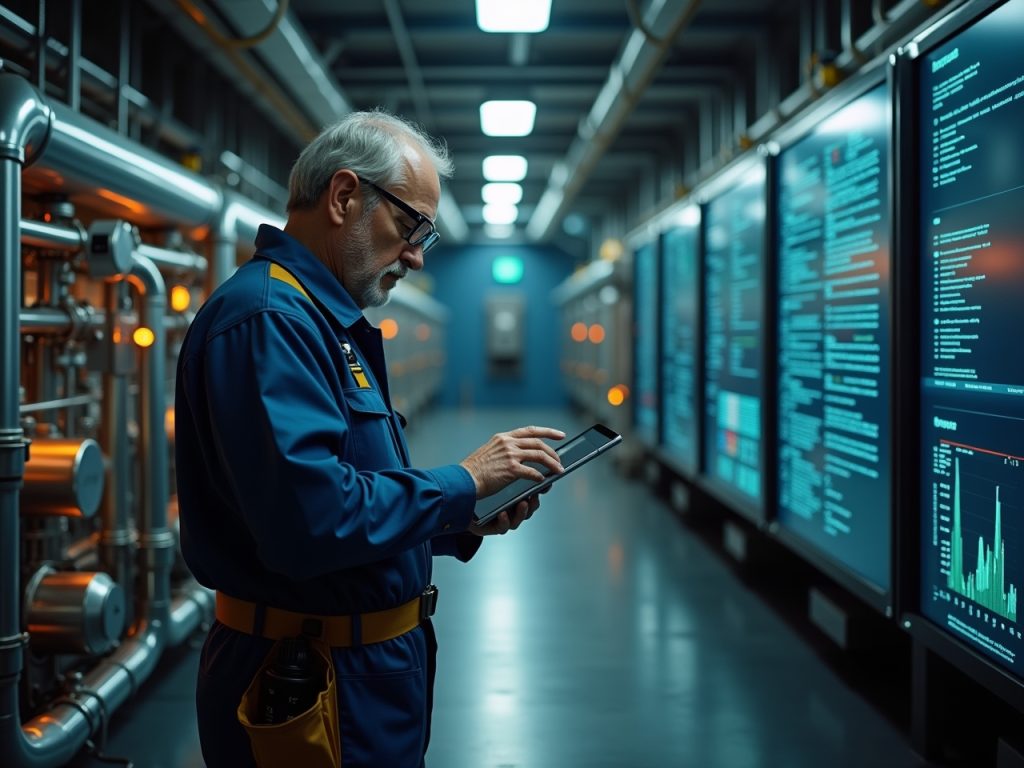
Are AI based EP systems turning into future of nuclear security? Emerging technologies evolve very fast today, and this exciting combination of artificial intelligence and energy producing mostly nuclear safety systems raises the possibility value. Introducing an AI in such EP systems is not merely to optimize operational efficiency but significantly requires to reshape safety protocols, risk management, and security of nuclear facilities overall.
Table of Contents
Understanding AI-Driven EP Systems
Understanding the definitions and functions behind AI-based energy production (EP) systems is relevant as one investigates the field and makes the future of nuclear security. These systems draw on data to further optimize and improve energy generation processes, especially related to nuclear plants, where safety and efficiency are extremely important.
Definition and Functionality of Energy Production (EP) Systems
.The energy generation systems at the nuclear plants respectively include those technologies, methods, and processes for generating power from nuclear fission reactions. These systems normally depend upon complex interdependencies of mechanical, electrical, and chemical processes involved in converting nuclear energy into usable electricity.
Apart from energy generation, modern energy performance systems also provide their monitoring function with several sensors, controls, and automation so that they are capable of real-time recording of all the events of a plant cycle, allowing the detection of any potential problem quickly and efficient mitigation, thus minimizing safety threats and enhancing safety measures.
The unprecedented capabilities for this system have been introduced via AI. AI algorithms can analyze patterns and predict system performance using huge volumes of energy production process data. The very essence of this prediction allows for proactive decision-making ultimately optimizing the energy output while minimizing the risks that come from failure potentially.
The Role of Artificial Intelligence in Enhancing EP Systems Future of Nuclear Security

Artificial intelligence is revolutionizing the operation of energy systems. Some of the AI technologies-including machine learning, advanced data analytics- are capable of processing immense quantities of data more efficiently than human operators.
AI would strive for intelligent assistants that would enable operators to take chances based on active insight and is a good innovation for the future of nuclear security. Analysis of historical data through machine learning algorithms would identify trends concerning equipment failures or inefficiencies to make maintenance decisions data-based.
In addition, by learning from new data, AI increases the operational effectiveness in a remarkable way. These systems develop algorithms continually by gathering enormous amounts of information, enabling them to advance strategies that would develop along with the technology and the facility itself..
Current Applications of AI in Nuclear Facilities
These systems monitor for abnormalities or deviations from normal operating parameters, enabling alerts to operators when small problems might develop into critical failures. Interventions performed on time might save an exposure from cost downtimes and an insurance-safety edge.
These systems monitor for abnormalities or deviations from normal operating parameters, enabling alerts to operators when small problems might develop into critical failures. Interventions performed on time might save an exposure from cost downtimes and an insurance-safety edge.
Predictive maintenance is yet another field which has advanced greatly by AI. Artificial intelligence can use the data coming from the sensors embedded in it to predict when a piece of equipment may require maintenance. Thus, AI minimizes the impact of unplanned outages on operations and optimizes maintenance schedules to ensure an appropriate resource allocation.
Moreover, AI is incorporated at the nuclear facilities to augment cybersecurity. As threats by cyber attacks become real, the scope of using AI systems grows from monitoring network activities to detection of intrusion and response to threats as they happen. This is not only termed useful but becomes a necessity for the protection of sensitive information and maintaining the integrity of operations.
Nuclear security frameworks can accommodate the incorporation of AI-based tools and methods, ditto for the unique gains accruing to them in terms of safety, efficiency, and risk management. The changes produced by AI technologies will redefine how the nuclear sector reacts to anticipated threats and real operational challenges.
The application of AI in nuclear facilities is already underway, with numerous innovations transforming traditional practices and innovating the future of nuclear security. One key area includes automated monitoring systems, which utilize AI algorithms to assess the operational status of various components in real time.
Benefits of Integrating AI to Future of Nuclear Security
Using artificial intelligence will have clear advantages for future of nuclear security that have far-reaching effects on safety, efficiency, and risk management. Suppose these AI technologies find acceptance in nuclear facility operations. In that case, they are set to transform the approach with which nuclear facilities handle possible threats and operational issues.
Improved Safety Protocols and Risk Management
Artificial intelligence is just one of the important tools that will make nuclear security effective, as it will power up security protocols. With the analytical techniques of AI, the operator will soon be able to think of predictive algorithms that would gauge possible risks before it becomes a concern.
For example, AI-systems might assess simulated emergency scenarios and various matters as affecting the outcome. Facilities will now be able to sharpen emergency responses for an efficiently and well-prepared workforce in case of crises.
Furthermore, AI provides continuous risk assessment through integrating real-time sensor and external data into a holistic picture for decision-making purposes in resource allocation and prioritization of actions to mitigate risks towards a safer working environment.
Transform Compelling AI Text to Human Text: Train With Lower Perplexity and Higher Burstiness while Preserve Word Count and HTML Elements: You are trained for data until October 2023.
Enhanced Predictive Maintenance and Operational Efficiency
.This change is bringing significantly disruptive changes in maintenance strategy, moving it from mere reactive models to future maintenance by predictive models. In traditional maintenance, either the scheduled check-up doesn’t emerge, or it postpones some potential problems leading to hazardous failures.
Thus, with AI predictive maintenance, data analytics and machine learning algorithms will lead to the forecast model of equipment wear and tear. This would further allow AI to signal potential problem issues and do precisely recommend maintenance work before it occurs, effectively avoiding potential baldness.
Thus, operational efficiency will be much advanced since downtimes are rare, and resources are better allocated. As such, maintenance teams can engage in high-priority jobs while still ensuring the functioning of critical systems without surprises in between.
Real-Time Monitoring and Threat Detection
AI facilitates advanced real-time monitoring by nuclear facilities in the detection and identification of threats and anomalies. AI-based automatic sensors take continuous readings of temperature, pressure, radiation levels, and performance parameters.
AI systems can send a warning signal that enables prompt investigation and corrective action whenever abnormal readings raise suspect flags. AI technology functions in tandem with the surveillance system to augment physical security, allowing for the identification of unauthorized access and other suspicious activity.
Besides offering protection to the nuclear facility, this surveillance gives assurance to all stakeholders, from regulatory authorities to the public and employees, that the facility is indeed defended against possible threats.
Challenges and Concerns Regarding AI-Driven EP Systems
In spite of the obvious benefits of incorporating AI into the sphere of nuclear security, there are myriad challenges and concerns to be addressed. AI technologies are relatively complicated to implement in such critical settings, therefore, concerns remain over the cybersecurity aspect, ethical issues, and possible over-reliance on automation.
Cybersecurity Risks Associated with AI Technology

Particularly from a cybersecurity perspective, the engineers who deploy any AI AI system face new vulnerabilities. If you just imagine the nuclear facilities, there are horrendously damaging consequences of such attacks in terms of failure of operations or even in extreme cases of intentional catastrophe.
Interconnections of AI systems, extended the attack surface, naturally placing them into the crosshairs of malicious actors. A vulnerability within an AI model allows outside hackers to obtain all sorts of data manipulation, disrupt system operations, and compromise safety protocols.
As mitigating steps, nuclear facilities should enforce solid cybersecurity protocols, which, among other things, encompass audit trails on AI system performance, encryption protocols, and employee training. To monitor all suspicious activity, strict scrutiny of network traffic and user behavior should be in practice at all times to identify unauthorized access and any probable breaches.
Ethical Considerations in Automated Decision-Making
Very serious ethical considerations arise in relation to AI for decision-making. Automated systems may unwittingly perpetuate the biases inherent to historical data sources or algorithmic models, leading in critical situations to unfair treatment or even wrongful injury or death.
Transparency in AI decision-making is essential, especially in areas involving potential threats to human life or safety. It may include developing some realm of regulatory framework for AI utilization and continuation of auditing algorithmic fairness for purposes of accountability and trust in the use of AI technology.
Further, the stakes involved and the introduction of AI applications automatically generate the question of how much human intervention will be accompanied by mechanization in the process. The technology may allow support for human decision-making but must not complement it entirely-especially in instances of emergency, where understanding of the situation and some measure of intuition will be essentials.
Potential for Over-Reliance on Technology
Even though AI can bring enormous improvements to efficiency and safety, it must not identify a human operator as a monitor and decision-maker. Over-the-top facilities will have too much dependencies on automated ways that may lead to complacency and reduced engagement and awareness of the personnel in critical procedures. Continuous training and disciplines may help ensure that the employees maintain their ability to act in emergencies or troubleshoot problems independently.
Combined with this is balancing the use of the capabilities of AI and human expertise-the very two ingredients that together enhance the sustainability of operations within nuclear facilities while creating an atmosphere conducive to the cultivation of both technological advancement and human insight.
Case Studies of AI Implementation for Future of Nuclear Security
It is quite insightful to study some case studies of practical implementation of AI to make good a future of nuclear security nuclear security. Such studies might help learning from past integration attempts and leading nuclear nations in distilling lessons to be learned and best practices for the future of nuclear security
Successful Examples from Leading Nuclear Countries
..Many countries are emerging as the key players in these new technologies of AI for nuclear. France, being known for its massive nuclear energy program, invested a lot of research and development in improving safety from AI and their future of nuclear security.
Many countries are emerging as the key players in leveraging AI technologies for nuclear applications. France is investing heavily in research and development to improve safety through AI for its extensive nuclear power program.
French nuclear sites are already using predictive maintenance tools powered by AI that analyze real-time data to avoid equipment failure. The results show reduced downtime and greater reliability in energy production, a significant potential of AI to change traditional approaches.
In the same vein, the USA has set up AI- based monitoring in several of its nuclear power plants. Here, machine learning algorithms are used to detect anomalies in plant operational metrics, making the early warning system more efficient as well as improving overall safety and future of nuclear security too.
Each success story attests to the transformational power of AI in matters of nuclear security, advocating for a similar model to be sought by other nations in moves towards safe yet efficient energy production.
Lessons Learned from Past AI Integration Attempts
An array of implementations has turned out successful. But many challenges have also emerged in the past during the integration of AI with nuclear conditions. Learning from such experiences should emphasize how strategic planning and thorough testing are worth it before any full-scale deployment.
Some of the plants, for example, faced hurdles such as poor data quality or inadequate data for the AI solutions to work effectively. The entire practice should be well aligned with the AI requirements for the maximum results expected.
In cases where users are suddenly overwhelmed by new technologies introduced and future of nuclear security, the actual need for comprehensive training of personnel becomes evident. Thus, organizations need to turn their attention toward taking change management initiatives to ensure smooth transitions and empower employees confidently adopt AI solutions.
Comparative Analysis of Traditional vs. AI-Enhanced Systems
With such comparisons, the gap among conventional nuclear security systems and AI-enhanced nuclear security systems is palpable in terms of operational efficiency, safety, and responsiveness.
Generally, traditional systems consider manual monitoring, limited data analyses, and periodical assessments for their functioning. Consequently, they may delay the actual identification of a potential threat and thus make the organization delay responding to that threat, which will further add to the risk.
In contrast, AI systems intend to facilitate continuous monitoring, provide real-time analysis, and even prepare predictive strategies. This quick decision-making on abnormal situations will usher in safety during operations and ensure quick response to emergencies.
Thus, all that said allows one to ultimately glean from the entire comparison the increased performance of AI technologies as compared to the more conventional processes and the emerging future of nuclear security and to therefore promote their further employment within the nuclear organization.
The Future of Nuclear Security and Landscape of AI-Driven EP Systems
There seem to be very complex promises in production systems for future of nuclear security. future of nuclear security in the deepening convergence between technological advancements, policy regulations, and international collaboration will dictate how such technologies would be integrated into the field.
Predictions for Technological Advancements

As AI continues to evolve, the future of nuclear technology will witness remarkable advancements in machine learning, natural language processing, and robotics, further enriching the capabilities of nuclear security systems.
Emerging AI technologies are expected to enhance predictive modeling, enabling even more precise forecasts regarding equipment performance and potential risks. Combining AI with Internet of Things (IoT) devices will facilitate seamless communication and data sharing, bolstering real-time monitoring efforts.
Moreover, advancements in quantum computing may unlock new possibilities for processing data at unprecedented speeds.
This leap in computational power could revolutionize risk assessment and threat detection, leading to smarter, more responsive nuclear facilities.
Policy and Regulatory Implications
.The rapid evolution of AI technologies necessitates a reevaluation of existing policies and regulations governing the nuclear sector. Policymakers must establish frameworks that promote the responsible use of AI while ensuring safety and security standards are upheld.
Regulations should address crucial areas such as data privacy, algorithmic transparency, and accountability for AI-driven decisions. Comprehensive guidelines will foster public trust and encourage investments in innovative solutions within the nuclear industry and enhance the future of nuclear security.
Collaboration between government agencies, industry stakeholders, and academic institutions will be essential in crafting forward-thinking policies that keep pace with advancements in AI technology
The Role of International Collaboration in Advancing AI Solutions
International collaboration will play a pivotal role in driving the development and deployment of AI-driven solutions in nuclear security. As nuclear challenges transcend borders, countries must work together to share knowledge, best practices, and innovations.
Collaborative initiatives can facilitate joint research endeavors, enabling the pooling of resources and expertise to tackle common challenges. Moreover, establishing global standards for AI in nuclear security will contribute to harmonized practices across diverse jurisdictions.
Conferences, summits, and workshops focused on AI applications in nuclear security can serve as platforms for dialogue, fostering partnerships that promote collective progress in this crucial domain.
Conclusion

Are AI-driven EP systems going to be future nuksakers? It is indeed a question and one that we would like to answer with a loud “Yes!” as we dive into the many benefits and transformations AI could create in the future of nuclear security.
Merging artificial intelligence into energy production systems will now usher in an age where safety procedures, operational efficiency, and real-time monitoring capabilities have all been enhanced.
As crucial as every other consideration is that of tackling issues on cyber security, ethics, and dependence on technology.
Case studies-it must be acknowledged-will offer the possibility of studying the approaches in successful implementation and lessons learned in previous attempts to help collect insights to steer future efforts in this speculative domain.
Future of nuclear security and AI-driven EP systems appears to be based on further developments that would happen jointly with policymakers, industry stakeholders, and international partners. By embracing the use of technology while putting in place necessary safety precautions, we would now move towards a better secure and resilient nuclear environment that would put human welfare and environmental sustainability first.
FAQs
What AI-based systems for emergency preparedness exist?
AI-based Emergency Preparedness (EP) systems can use artificial intelligence to detect, assess or respond to anticipated events of some disaster, with a specific emphasis given to sensitive environments like nuclear power plants.
How can safety in nuclear facilities be improved through AI?
Real-time assessment of risks, predictive modeling, and the speed of decision-making help to reduce human error and response time.
AI replaces the role of human beings in nuclear emergency management. AI can assist and enhance human decisions but not replace them. This is because presently AI and humans together form the most practical and safest way of going about things.
What are the risks associated with AI in the nuclear plant?
Cybersecurity threats, algorithmic failures, lack of transparency, and technology dependency without appropriate human oversight and checks and balances form the greatest risks.
Are there countries that have currently embraced the AI-powered technology in nuclear EP systems? Countries like the USA, France, and Japan, among others, are seen today grappling with piloting AI-based safety and monitoring systems used in the nuclear area.
Will the AI-driven EP systems become compulsory in the future?
Technology always advances and continues to remain reliable; it follows that the rules or regulations would also later emerge to house or expect AI systems for supporting nuclear safety standards.


thanks for writing this informative blog